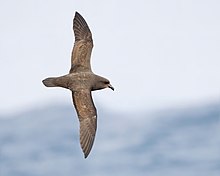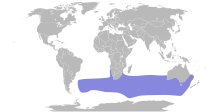
Great-winged petrel

| Great-winged petrel | |
|---|---|

| |
| Scientific classification | |
| Domain: | Eukaryota |
| Kingdom: | Animalia |
| Phylum: | Chordata |
| Class: | Aves |
| Order: | Procellariiformes |
| Family: | Procellariidae |
| Genus: | Pterodroma |
| Species: | P. macroptera
|
| Binomial name | |
| Pterodroma macroptera (Smith, A, 1840)
| |

| |
The great-winged petrel (Pterodroma macroptera) is a petrel living and breeding in the world's Southern Ocean.

Taxonomy
This species was formerly treated as containing two subspecies - P. m. macroptera and P. m. gouldi, the latter of which is endemic to New Zealand. As of 2014, the latter is recognized as a species in its own right, the grey-faced petrel (Pterodroma gouldi).[1] In 2016 further research was published supporting the full species status of the grey-faced petrel.[2]

Description
This is a large seabird, with a body length of 42–45 cm. The bird is completely dark brown except for a variable patch of white near the base of the bill, which is black.[1]

It is separated from sooty shearwater and short-tailed shearwater by the all-dark underwing, the thick, stubby bill, and different jizz. The similar flesh-footed shearwater has a light, pinkish bill. Petrels in the genus Procellaria are larger and have a less bounding flight.[citation needed]

Distribution
The great-winged petrel breeds in the Southern Hemisphere between 30 and 50 degrees south with colonies on Tristan da Cunha, Gough Island, the Crozet Islands, the Prince Edward Islands, the Kerguelen Islands and on the coasts of southern Australia. It is a rare vagrant to the Pacific Ocean off the coast of California, United States.[1]

Ecology
The species feeds mostly on squid and to a lesser degree on fish and crustaceans. Prey is generally caught at night, by dipping and surface-seizing. The great-winged petrel will on occasion follow whales and associate with other related bird species to feed. Breeding occurs in the southern winter (beginning in April); nests are either solitary or in small colonies, located in burrows or aboveground among boulders or low vegetation.[1]

Gallery
-
Great-winged petrel (Pterodroma macroptera), east of the Tasman Peninsula, Tasmania, Australia
-
Young bird
References
- ^ a b c d e BirdLife International (2014). "Pterodroma macroptera". IUCN Red List of Threatened Species. 2014: e.T45048812A45049213. doi:10.2305/IUCN.UK.2014-2.RLTS.T45048812A45049213.en.
- ^ Wood, Jamie R.; Lawrence, Hayley A.; Scofield, R. Paul; Taylor, Graeme A.; Lyver, Phil O'B.; Gleeson, Dianne M. (May 2016). "Morphological, behavioural, and genetic evidence supports reinstatement of full species status for the grey-faced petrel, (Procellariiformes: Procellariidae)". Zoological Journal of the Linnean Society. doi:10.1111/zoj.12432.
Further reading
- Harrison, Peter. Seabirds of the World: A Photographic Guide. Princeton University Press, Princeton, New Jersey, 1987, ISBN 0-691-01551-1
- Marchant S, Higgins PJ (1990) Handbook of Australian, New Zealand & Antarctic birds, Volume 1, Part A: Ratites to Petrels, Vol. Oxford University Press, Melbourne
- "Great-winged Petrel Pterodroma macroptera". BirdLife International Species Fact Sheet.
External links
- IUCN Red List least concern species
- Pterodroma
- Fauna of Tristan da Cunha
- Fauna of Gough Island
- Birds of Southern Africa
- Birds of the Indian Ocean
- Birds of subantarctic islands
- Birds of Australia
- Birds of Tasmania
- Birds of New Zealand
- Fauna of the Crozet Islands
- Fauna of the Prince Edward Islands
- Birds described in 1840
See what we do next...
OR
By submitting your email or phone number, you're giving mschf permission to send you email and/or recurring marketing texts. Data rates may apply. Text stop to cancel, help for help.
Success: You're subscribed now !



